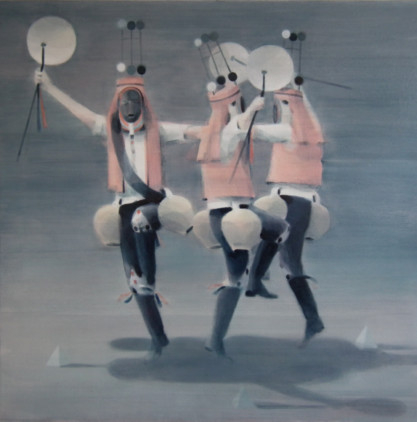
The phrase, “So long and thanks for all the fish” appears in the fourth book of the sci-fi series “The Hitchhikers Guide to the Galaxy” written by Douglas Adams. It is a farewell message from the dolphins when they leave Planet Earth just before it is demolished to make way for a hyperspace bypass. The quirky phrase is an apt title for Lawrie Shabibi gallery’s final show for this season, which features artworks that have elements of science fiction and fantasy, and a sense of the absurd and the surreal. The group exhibition includes paintings by British artist Adam Dix, photographic works by Egyptian artist Basim Magdy, and videos by US based Iranian artist Tala Madani and Taus Makhacheva from Russia. The four artists are all winners of prestigious awards, and their works in this show were originally created for important biennials and museum shows.
Dix’s neo-futuristic paintings explore our fascination with modern communication technology and our dependence on it. The London based artist presents what looks like a post apocalyptic world, where communication devices such as satellite dishes and phone masts take on the aura of revered spiritual icons. His muted palette and the strong, dramatic lighting in his paintings effectively convey our collective sense of awe and wonder about these objects. Merging folklore, religion and science fiction, the paintings depict people wearing tribal masks and costumes participating in primitive shamanic rituals of worship around these icons; or a choir singing to them, commenting on the loss of individuality in a collective idolisation. His beautiful, but disturbing paintings question the absolute faith we put in new technology, and compel viewers to contemplate how that is affecting our lives and our society.
Madani studied at Yale University School of Art and is presently based in Los Angeles. She is known for paintings that look incisively and irreverently at Middle Eastern culture and gender issues. The artist uses a gestural, expressionistic style in her work, which addresses diverse themes ranging from terrorism and tattoos to body hair removal and prayer. She usually represents the men in her paintings in a child-like simplified style, creating uncomfortable scenes where bald, middle aged men engage in absurd scenarios that fuse playfulness with violence and perversity. Her gestural, expressionist style is also reflected in her video animations. The animated video featured in this show is titled “Eye Stabber” and shows a man, standing in a sinister alleyway. As he snips pieces out of his shirt with scissors, his torso becomes covered with eyes. Overcome by this curious turn of events he lashes out, violently attacking every eye and inflicting wounds on himself. He eventually escapes the bloody mess and propels his shrunken form into a rubbish bin. The fantasy scenario makes a powerful statement about the current socio-political environment, provoking viewers to think about their attitudes and perceptions of what is happening around them.
Moscow based Makhacheva’s performance video, “A Space for Celebration” focuses on the absurdity of highly commercialised lavish wedding celebrations, commenting on how traditional social rituals are being transformed into strange and curious spectacles in modern times. The humorous video has been shot in a typically ornate wedding hall in Dagestan, from where she comes. The ghostly figures of the bride and groom, dressed as “giant deconstructed napkins” are seen wandering alone through the empty banquet hall. You see the bride walking in between the tables that are laid out for the feast and the groom rolling about on the carpet like a turtle tipped on its back. The vacant hall and the haunting presence of the figures urges viewers to reflect on the meaningless waste and display of wealth and the emptiness and loneliness that is hidden beneath the outwardly show. By focusing on an event that is common to all cultures and speaks to the heart of human existence, the artist tries to rediscover the real traits and values that make us distinct and extraordinary.
Magdy, who lives and works in Basel and Cairo, is a winner of the 2014 Abraaj Group Art Prize. He looks at iconic images and objects that seemingly have no historical or political significance, and studies the social implications of such symbols, and their transformation over time that result in a mix of legend and bizarre cultural constructions and encounters. He is presenting a selection of photographs from his ongoing photographic series — “Every Subtle Gesture”. The pictures of buildings, plants, dinosaurs, a shelf full of sculpted busts, and other random objects and sights are presented as though they are images on an old fashioned television screen, and they are paired with enigmatic phrases coined by the artist, to create an undecipherable narrative. The phrases such as “Still ten more days to Sunday”; “This is the time of lofty goals reached by the wrong people”, and “Coming home from their expedition they found a different city” have no apparent connection with the pictures, but together they encapsulate a surreal moment giving the feeling that each piece is a fragment of an imaginary tale, and beckoning viewers to turn the ambiguity into a magical story of their own.
The work highlights the fact that our understanding of events, including revolutions is highly subjective and based on individual social, political and cultural contexts and beliefs.
The show will run at Lawrie Shabibi gallery, Al Quoz until July 17.













